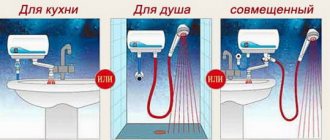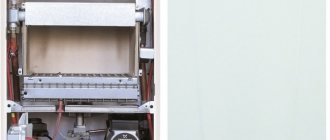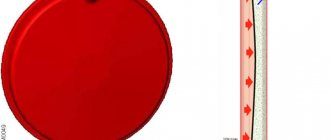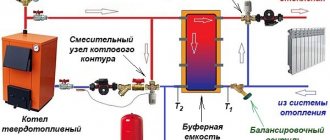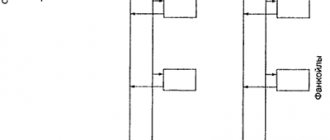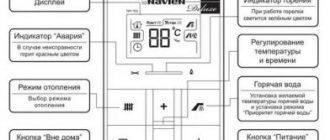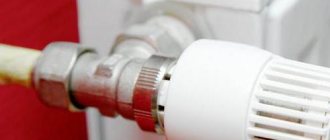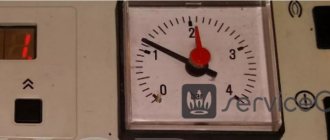Correct selection of a water heater with indirect heating
The indirect heating boiler (IBC) is a highly efficient device with modern automation systems for thermal processes, used to produce hot water T up to 65 C.
Externally, the BKN is similar to a traditional electric water heater, although its modern modifications have a more ergonomic rectangular shape.
The source of thermal energy is a heating boiler that runs on any energy source from waste to electrical energy.
The basic element is a steel or brass coil-type heat exchanger with a large heating area in a relatively small volume of a storage tank coated with a protective enamel layer.
To impart heat-storing functions to the battery tank, the outer surface of the structure is covered with a heat-insulating layer and an additional protective casing.
Before installing the BKN, it is necessary to correctly select it for the actual operating conditions: the source of heat supply and the volume of water use for DHW services.
Basic parameters for choosing a connection diagram for an indirect heating boiler:
- Working volume in liters. At the same time, the terms “total volume” and “working volume” are different, since the coil heat exchanger takes a certain part of the tank, so you need to choose according to the working indicator.
- External heating source, fuel type and coolant outlet temperature.
- Thermal power of an external source. The boiler must provide not only the heating load, but also DHW. So, to heat a volume of water of 200 liters, a reserve power of at least 40 kW will be required.
- Material of the working container: coated with enamel, glass ceramics and glass porcelain, stainless metal or heat-resistant plastic.
- Thermal insulation - to protect the BKN from heat losses, it is best if polyurethane is used as thermal insulation.
- Protection and regulation system.
Important Features
In addition to choosing the geometric and thermal characteristics of the BKN, it is necessary to take into account many parameters so that the thermal circuit for connecting an indirect heating boiler to a gas boiler is as efficient as possible.
To do this, the user must fulfill certain conditions:
- Choose the optimal location; experts say that the location of the BKN should be as close as possible to the boiler.
- To provide protection against thermal elongation of the structure, to do this, integrate a membrane hydraulic accumulator with a volume of 10% of the working volume of the boiler into the BKN circuit at the DHW outlet from the device.
- Before connecting the boiler, each supply/discharge line for the heating and heated medium is equipped with ball valves.
- To protect against backflow, a check valve is installed on tap water.
- Water purification is carried out with the installation of a filter before supplying tap water to the BKN.
- The installation of the BKN wall structure is carried out on permanent walls with preliminary treatment with fireproof materials.
- The installation of the BKN is carried out above the level of the boiler unit or at the same level as it.
Selecting tank volume
In the trading network today there are many offers for BKN devices, both domestic and foreign manufacturers, with containers of round and rectangular cross-section, floor and wall mounting. And if for electric heaters the most popular are models with a volume of 80 to 100 liters.
For BKN, more powerful options are used, ranging from 200 to 1500 hp. This is due to the fact that many owners use this design to create a storage tank in order to create a uniform load on the heat supply source at night. In this scheme, water for domestic hot water is heated at night and consumed during the day.
The size of the working tank is chosen taking into account the need to provide all family members with hot water. There is a formula for calculated water consumption.
In practice, the following data is often used:
- 2 users - 80 l;
- 3 users - 100 l;
- 4 users - 120 l;
- 5 users - 150 l.
The dimensions of the BKN are also important to consider during installation. For wall-mounted installations, installations with a tank working volume of up to 150 liters can be used, while larger sizes can only be installed with floor-mounted installations.
The installation site must have free access so that the piping can be properly completed and auxiliary equipment in the form of shut-off and control equipment, safety valves, air vents, pumps and a hydraulic accumulator can be placed.
What is an indirect heating boiler
Today, more and more people are resorting to using indirect heating boilers. This useful device allows you to use the heat of a gas boiler more efficiently. In winter, when the heating system is turned on, the indirect heating boiler operates from this system, and in summer, when the boiler does not operate for heating, such a boiler operates from an electric heating element or the boiler is switched to summer mode (if settings allow).
Heating of water in an indirect heating boiler does not occur in a direct way, but in a kind of incidental way. Inside such a boiler there is a fairly large coil, inside which coolant from the heating system circulates. Thus, the gas boiler heats the water in the indirect coil, which circulates in the heating system with the help of a pump, and the heat exchanger heats the water that is in the boiler. This type of water heating for the DHW main is recognized as the most cost-effective.
The casing of this boiler is mainly made of steel sheet, and its inner part is made of stainless steel. Between the outer and inner parts of an indirect heating boiler there is a special material that almost does not conduct heat. The design of such a boiler is very similar to the design of a thermos.
As a rule, an indirect heating boiler is installed near the heating boiler. The heated coolant must pass through the boiler first. The water in such a boiler will always be hot, and several hot water sampling points can be connected to this boiler at once. Hot water is heated in an indirect heating boiler without damaging the operation of the heating system.
In most cases, such a boiler is equipped with a highly efficient heat exchanger, which is made of special steel. More expensive indirect heating boilers are equipped with heat exchangers made of brass. The boiler heat exchanger has the shape of a long spiral, which allows you to very quickly heat the water to the temperature that the water in the heating system currently has.
How does a boiler work in tandem with a boiler?
There are several schemes for connecting the BKN to a gas boiler. They depend on the type of boiler and its power, type of fuel and heating circuits. Before installing a water heater in the DHW circuit, you will need to choose the principle of its inclusion according to the supply coolant: with or without priority.
In the first option, a high-speed mode for water preparation in the storage heater is provided, when all the coolant from the boiler unit passes through the BKN coil. After reaching the set temperature of the hot water in the tank - 65 C, according to a signal from the thermostat, the coolant enters the intra-house heating system.
The second option is implemented by a separate heating circuit of the boiler unit, with a calculated flow rate of the heating medium through the BKN. It is not regulated in any way, works in the “open-closed” modes and does not affect the heating.
Boiler to boiler connection diagrams
Before connecting an indirect heating boiler, an executive connection diagram and installation parameters for the BKN are developed. They depend on the modification of the device, the boiler unit layout and the heating system in the household.
It is extremely important to choose not only the type of installation, but also the location of the BKN in relation to the boiler unit and installed pumps in order to ensure the efficiency of the heating system as a whole.
The most commonly used boiler connection kit is BKN for dual-circuit units and with three-way valves.
Piping with boiler water circulation pumps
A circuit with 2 electric circulation pumps is used for temporary heating of hot water supply, for example, during seasonal operation of the BKN and when used on weekends. In addition, this option is applicable when the DHW temperature is set lower than the coolant temperature at the boiler outlet.
It is performed with two pumping units, the first is placed on the supply pipe in front of the BKN, the second on the heating circuit. The circulation line is controlled by an electric pump through a temperature sensor.
Based on its electrical signal, the DHW pump will be turned on only when the temperature drops below the set size. There is no three-way valve in this version; the piping is performed using conventional mounting tees.
Connection with a non-volatile boiler unit
This scheme is used for a non-volatile boiler unit operating with natural coolant circulation, therefore, in order to ensure the required hydraulic mode, the coolant could circulate through the boiler unit and radiators in the rooms. This diagram is for wall modifications that allow installation at a level of 1 m from the “O” mark in the combustion chamber.
Floor-standing models in such a design will have low circulation and heating rates. A situation may arise that the required heating level cannot be achieved.
This scheme is used only for emergency modes when there is no electricity. In conventional energy-dependent modes, circulation electric pumps are installed in the circuit to ensure the required speed of coolant movement.
Trim with 3-way valve
This is the most common piping option, since it allows parallel operation of both heating and hot water. The circuit has a fairly simple design.
The BKN is installed next to the boiler unit; a circulation electric pump and a three-way valve are mounted on the supply line. Instead of one source, a group of boilers of the same type can be used.
The three-way valve functions as a mode switch and is controlled by a thermal relay. When the temperature in the tank decreases, the temperature sensor is triggered, sending an electrical signal to the three-way valve, after which it switches the direction of movement of the heating water from heating to DHW.
In essence, this is a BKN operating scheme with priority, ensuring rapid heating of the hot water supply when the radiators are completely turned off during this period. Once the temperature is reached, the three-way valve switches and the boiler water enters the heating system.
Scheme with recirculation line
Coolant recirculation is used when there is a circuit in which hot water must circulate all the time, for example, in a heated towel rail. This scheme has great advantages, since it does not allow water to stagnate in the pipes. The user of hot water services will not need to drain significant volumes of water down the drain in order for hot water to appear in the mixer. Consequently, recycling saves costs on water supply and hot water services.
Modern large BKN installations are supplied to the market with a built-in recirculation system, in other words, they are equipped with ready-made pipes for connecting a heated towel rail. Many people purchase an additional small tank for these purposes, connected to the main BKN through tees.
Is it possible to connect a boiler to a double-circuit boiler?
This option is carried out using a connection diagram for an indirect heating boiler with a hydraulic arrow for structures with a working volume exceeding 220 liters and multi-circuit heating schemes, for example, in a multi-storey building with a “warm floor” system.
Gidrostrelka is an innovative component of a modern intra-house heating system that simplifies the operation and repair of a water heater, since it is not necessary to install recirculation electric pumps on each heating line.
It increases the safety system, since it prevents the occurrence of water hammer, since it maintains equal pressure of the medium in the circuits of the double-circuit boiler unit.
Correct installation of a wall-mounted gas boiler
The gas boiler of this modification has a self-diagnosis function. Baxi heating systems and their maintenance Although Baxi devices and systems are famous for their reliability and durability, trouble-free operation, gas boilers still require periodic maintenance and repair work. All of them are double-circuit due to the installed bithermic heat exchanger, and have electronic protection against scale. If you look closely at the diagram, you will see that the system includes both a radiator system and a heated floor system. Make electrical connections according to the electrical diagram given in the instructions.
Note that when the fan, circulation pump and boiler are operating at full power, the battery charge will be enough for approximately 11-12 hours of operation, which is quite enough for the emergency situation to be resolved. If you need to perform welding work, it is recommended to use gas welding. They are equipped with three-way valves and temperature sensors to control the operating modes of the heating boiler. Next it enters the heat exchanger. When installing a Baxi double-circuit gas boiler, it is better to place it in the kitchen next to a gas stove. The circulation pump is designed in an energy-saving mode, with automatic removal of air from the system.
And so, having passed through all the radiators, the coolant finally enters the return pipeline. Expansion tank; 11a. It is possible to connect a programmable timer. Primary heat exchanger; 11b.
Automatic bypass; Possibility of working on liquefied gas after reconfiguration.
Gas valve. At the same time, the maximum power consumption of the electrical network is 25.8 kW, and the largest heating area is square. Main 5 boilers are equipped with a bithermic heat exchanger, which simultaneously heats both running water and coolant. And so, having passed through all the radiators, the coolant finally enters the return pipeline.
In the photo you can see the location of the various parts under the cover. Heating circuit temperature sensor; Connecting the Emmeti Termec room thermostat to a baxi gas boiler
Connecting a boiler to a water supply system made of different materials
The boiler is connected to a heat supply system using both traditional steel pipes and more modern polypropylene and metal-plastic pipes. A cheaper option is polypropylene.
The choice will depend on the price of the project and the operating temperature of the heating fluid at the outlet of the boiler. For example, in a solid fuel boiler, the coolant temperature is difficult to regulate; there may be cases where it will spontaneously rise to 100 C, so in this case it is better to install steel pipes.
Although they are less durable, they are designed for the high temperature operating conditions of solid fuel devices.
Polypropylene pipelines
Polypropylene pipes are easily installed using a specialized soldering iron and scissors for cutting pipelines. After selecting the connection point, a section in the pipeline is cut out in width equal to the tee, with a deduction of 20 mm: 10 mm for each.
Using a soldering iron, heat the pipe and fitting to the required technical condition and connect them. At the same time, it is forbidden to scroll them, since this can disrupt the tightness of the connection.
Next, connecting parts of pipes of various lengths and angles, a connection is made to the BKN nozzles. A threaded coupling is soldered to the end of the pipe section and then the entire line is firmly connected.
Insertion into a metal pipeline
Today, it is possible to connect the BKN to water supply utilities without the use of welding; for this, there is a modern “vampire” adapter device, which has a technological hole and a clamp in the body. Installation of this design is very simple. Select a cutting point and clean the area.
A clamp with a heat-resistant gasket is installed on top of the prepared area and tightened with bolts to secure it. Next, turn off the water supply and drain it from the desired section of the pipeline by opening the hot water tap on the mixer.
Next, the pipe section is drilled through the hole in the clamp with an electric drill and then the valve is screwed on and the BKN piping is continued according to the diagram.
Metal-plastic
This is the most reliable and simplest option for connecting a BKN boiler to a double-circuit boiler. The metal-plastic material is simply bent to the desired outlet angle, and the connections of the nodes are made with various crimp fittings.
Before tying the BKN, the pipe is cut to the required length and size. Next, select the insertion point, taking into account the size of the tee and the part of the pipe that will be occupied by the connection.
To prepare a hole in a small area, special scissors are used. The nuts are removed from the tee and, together with the fixation rings, they are put on different ends of the pipe. Flare the ends of the metal-plastic using a special calibrator or screwdriver.
The tee is inserted all the way, then the rings are moved and the nuts are tightened with a wrench. You can also use fittings for metal-plastic pipes, which will require crimping and additional specialized tools and devices.
Connecting the boiler to the electrical network
An indirect heating boiler does not use electricity for the main heating process. It is used in high-tech modern BKN devices for the operation of electronic control and protection systems.
Since the control unit requires low power to operate, the BKN device is connected through a regular socket equipped with a grounding contact.
In order to correctly connect the boiler to the electrical network, you will need an electrical diagram drawn up by specialists. It should provide that the cable is laid in a hidden way and connected to the nearest electrical box or directly to the electrical panel.
In a convenient place, install a two-pole 20 A circuit breaker in a protective plastic box, connect a cable to it with clamps, which goes to the furnace and can also be sent to a double-circuit gas boiler to power the automation system and circulation pump.
Strapping schemes
The design of a double-circuit boiler involves connecting five pipes to it. Four will be fixated on water, and one on gas. Everything is clear with the gas pipe - it is connected through a gas ball valve to the burner. With water pipes it is a little more complicated:
- One pipe connects the first coolant pipe to the return circuit of the heating system.
- The second connects the same coolant from the opposite side to the supply pipe.
- The third pipe connects the water supply to the second coolant pipe.
- The fourth is the second pipe of the same coolant with a pipe that supplies hot water to the hot water system.
Visual diagram
And now the principle of operation. In the pipe circuit of the double-circuit unit, a three-way valve is installed, which operates from the device’s automation. When the tap is opened to consume hot water, the heating is switched off.
Essentially it goes like this:
- The coolant from the main heat exchanger is redistributed.
- The three-way valve closes the heating circuit and transfers the coolant flow to the second heat exchanger. Here the cold water from the tap begins to heat up due to it.
- As long as hot water is consumed, the three-way valve will remain in this position. As soon as you close the mixer, it immediately switches to the main job, that is, heating.
This scheme of operation of a double-circuit gas boiler is not very effective. The bottom line is that it cannot provide the required amount of hot water for a large family. Typically, only one water intake point can be provided in this way. For example, a kitchen or shower. And this is a very big inconvenience. In addition, the water will not be hot, but warm, because the boiler will not have time to heat it to the required temperature.
What to do? There is only one way out - install an additional boiler in which the water will be heated to the required temperature. And the volume of the boiler can be selected so that there is enough water for everyone.
Boiler wiring diagram
You yourself understand that the number of pipe outlets has not changed. The hot water supply scheme itself has changed. In this case, the second heat exchanger is looped with the boiler heating circuit.
Wall-mounted boiler and boiler
It turns out like this:
- The first pipe of the second heat exchanger is connected to the incoming pipe of the boiler.
- The second pipe is connected to the second outlet pipe of the boiler.
But in this case the water supply is not connected to the heat exchanger, but is in contact with the boiler. From it, hot water flows into the hot water system. That is, the boiler will also have 4 pipe water connections.
The advantages of such a scheme are obvious:
- Typically, the water in the tap water is not of high quality, so the heat exchangers quickly become clogged. Practice shows that after a year of operation they require repairs.
- There is no need to switch the three-way tap, that is, when hot water is consumed, the heating system operates normally.
But here the question arises - why is it necessary to install additional capacity to a double-circuit gas unit? Isn't it easier to use a circuit with a single-circuit device? After all, the latter is much cheaper than the former. Who needs these costs?
That's right - you shouldn't buy a double-circuit gas boiler and then install a boiler on top of it. This is unprofitable from all points of view. But different things happen in life. Many country residents already have gas units with two circuits installed in their homes, but there is not enough hot water. So what - buy a new single-circuit boiler and redo everything? There is no point in this. You just need to buy a boiler of the required volume, install it and connect it to the system. This will be easier, especially since it concerns doing the work yourself.
Wiring diagram with an electric boiler
Designing a boiler installation
There is another option that will allow you to heat water for household needs to a certain temperature. To do this, it is better to use a storage-type electric heating device.
The wiring diagram here is slightly different, although it practically repeats the first option:
- The first pipe of the second heat exchanger is connected to the water supply network.
- The second pipe connects to the electric boiler.
- A pipe is led from the boiler to the DHW system, that is, to the mixers.
It turns out that when you open a hot water tap, the heating unit begins to work in exactly the same way as in the case of direct water supply. That is, the three-way valve turns on. But in this case, water from the boiler first enters the electric storage tank, where it is additionally brought to the set temperature by a heating element.
Why is this scheme beneficial?
- Firstly, the storage heating device will maintain the required water temperature.
- Secondly, this water will be enough if you correctly calculate the volume of the boiler.
- Thirdly, the entire system will operate in economical mode. And this means a reduction in fuel consumption costs. By the way, the electric boiler itself will consume less electricity due to the fact that the water will flow into it already warm.


